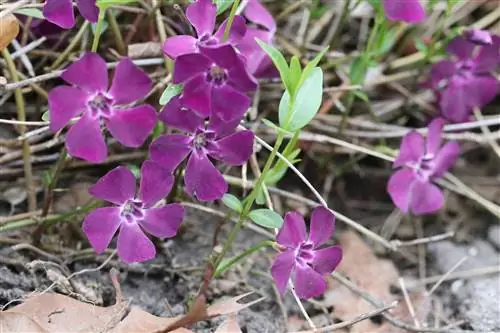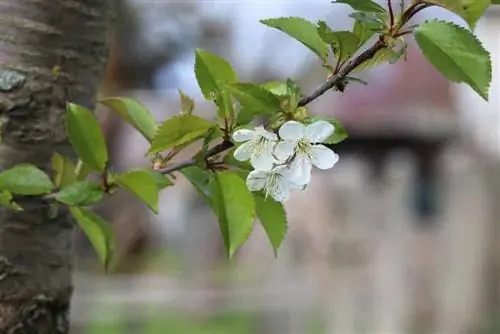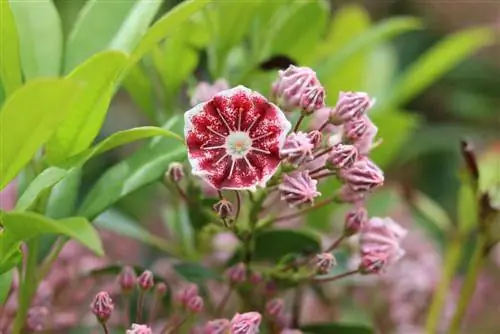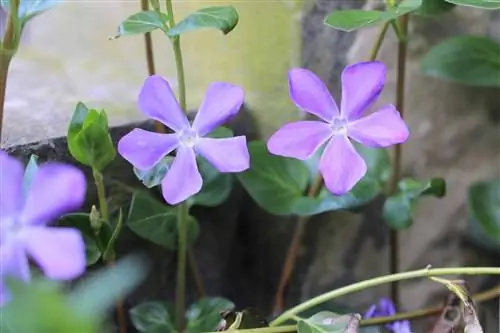- Author admin [email protected].
- Public 2023-12-17 03:39.
- Last modified 2025-01-24 12:45.
With a height of 15 to 30 cm, the small evergreen skilfully highlights walls, pond edges, beds and trees. The delicate flowers on dark green leaves are reminiscent of fairy tales about fairies and goblins.
The small periwinkle is a herbaceous plant. She is a persistent and welcome guest in our gardens. 'Vinca minor' forms runners (stolons). After being separated, they root themselves independently and grow into dense cushions that instantly enchant beds, pond edges, slopes and walls with flowers and evergreens. The first flowering begins in April and ends with the secondary flowering in September. The leaves are rich green, slightly shiny and form an attractive contrast to the delicate flowers. The small periwinkle is particularly popular and well-known as a ground cover that hardly gives weeds a chance.
Profile
- small periwinkle (also called small periwinkle) belongs to the dogpoison family
- ‘Vinca minor’ grows ground cover
- perennial plant
- evergreen, slightly shiny leaf
- Flowering period from March to June
- Re-blooming until autumn
- Growth height 10 to 30 cm
- Growth width 30 to a good 100 cm
- good winter hardy, protect from very deep frost
- 5 to 10 plants per square meter
Location
'Vinca minor' feels particularly comfortable in partially shaded to shady locations. However, very dark locations are not suitable. The small periwinkle suffers from dark locations. A warm location with humus-rich, fresh and permeable soil is optimal. The plant tolerates calcareous but also slightly acidic soil. The small periwinkle does not tolerate cold and wet locations. As well as heavily compacted and heavy soils.
Tip:
When selecting the optimal location, it is important to note that the small periwinkle belongs to the dog poison family and is therefore poisonous. Children and pets should not come into contact with the plant.
The small evergreen can be planted all year round. However, spring is the best time. Now the plant has plenty of time to grow well and develop strong roots. Despite its toxicity, the small periwinkle is an asset to any garden.
Care
If you follow the care instructions, the small periwinkle will be an expressive splash of color in the gardens for many years.
- Location sunny, partially shaded to shady
- optimal planting distance 30 cm
- Soil should be loose, humus-rich and nutrient-rich
- enrich sandy soil with peat
- water only during long periods of drought
- Giving compost in spring
- Pruning only if necessary
- plant 6 to 8 plants per square meter as ground cover
After rainy summers, the young shoots often grow sparsely next spring. Too many nutrients have been washed out of the soil. Leaf mulch, hardwood chips or compost, which are incorporated around the plants in early spring, can help. Because nutrients are released gradually over long periods of time, the plant can grow and bloom vigorously. If artificial fertilizer is to be used for the sake of simplicity, this must be repeated regularly during the growing season.
Cutting
- ‘Vinca minor’ does not necessarily need to be pruned
- Pruning possible if it spreads too much
- ‘Vinca minor’ can also tolerate severe pruning
- Pruning is best done in March
- the plant can be cut just above the ground
- make sure that there are enough branches with sleeping buds, because the plant will sprout again from these
- the more branches are retained, the bushier the small periwinkle grows back
- Cuttings can be cut from the clippings to propagate the small evergreen
Propagation
Cuttings for propagation can be cut from spring to autumn. The cutting should have 1 to 2 pairs of leaves. Then it is placed in moist, commercially available potting soil or moist peat. Roots form after just a short time. The small plant can then be placed in planters on the balcony or terrace or they can be placed directly in the garden. The soil should be loosened well before planting the rooted cuttings.
Propagation can also be done by dividing the plant. Here too, spring is the best time. To do this, a strong plant is dug up. Divide the root ball into pieces with sufficient roots. The sections can be planted immediately at the new location. Just water it and the small evergreen will grow without any problems.
The small evergreen is robust, easy to care for and can be used in more than just the garden. It also looks enchanting in planters and flower boxes. It grows densely and climbingly. As a planting partner with upright roses, daisies, fuchsias or geraniums, the effect of 'Vinca minor' is enchanting. The substrate should be loose and rich in nutrients. The irrigation water must be able to drain away, because waterlogging is fatal for the small periwinkle.
Wintering
'Vinca minor' is robust and hardy down to minus 20 °C, depending on the species planted. Only plants that were planted in late summer or autumn require light protection from brushwood in the event of very severe frost. If the sun shines in winter but the ground is frozen, the plant is at risk of drying out. Their evergreen leaves evaporate water even in winter, but the roots cannot absorb water because of the frozen ground. Additional shading can provide protection against cold frost.
Diseases & Pests
The small periwinkle is robust and easy to care for. Where it grows, not only does it hardly allow weeds to grow, it is also resistant to diseases and pests. Even the slugs, feared by gardeners, are given a wide berth and the small periwinkle. Experienced hobby gardeners therefore like to use 'Vinca minor' as a bed border to protect other plants.
Phoma stem rot can cause problems for small periwinkles. It causes rot on leaves and stems. Entire nests of shoots and leaves are attacked. The affected parts of the plant first look dirty green and then turn black. This disease usually occurs in humid weather and low temperatures between 10 and 15 °C. All infected plant parts should be removed immediately and rigorously destroyed. They don't belong in the compost. Phoma stem rot is primarily transmitted by flea beetles. Carefully spraying onion or garlic manure drives away flea beetles and stops the infestation.
Frequently asked questions
How many plants do I need if I want to grow an area quickly?
10 to 12 small evergreen plants per square meter are sufficient for a quickly dense planting.
Is bark mulch suitable for covering the small periwinkle?
No, because bark mulch releases tannic acid. This not only affects the growth of the plants, it also promotes the growth of horsetail.
What you should know about the small periwinkle
- The Vinca minor, in German small evergreen, belongs to the dogpoison family and is an evergreen, ground-cover plant.
- Their leafy shoots always remain close to the ground and the flowers, which bloom in spring and summer, grow towards the sun.
- The leaves of Vinca minor are green and leathery and appear slightly yellow on the underside. The largest leaves reach a length of up to 4 cm.
- The mostly hermaphrodite flowers, which almost always have five petals, are small and purple-violet. The bases of the flowers form a tube.
- The wild Vinca minor are almost never white, but always purple.
- The small periwinkle is very adaptable. It grows almost everywhere, is a very sociable plant, which spreads steadily and forms long shoots.
- The plant prefers fresh humus, also loamy and clayey. The location should be shady to slightly sunny.
- The small periwinkle was largely cultivated by people and that is why you can still see the areas where the Vinca minor was planted today.
- The small periwinkle is highly toxic in all its parts and is therefore only suitable for the garden and balcony to a limited extent. Children should be denied access.
- You should especially make sure that the Vinca minor is not exposed to too much sunlight in winter, otherwise the leaves will suffer greatly.
- Water the plant moderately and not too often, as it prefers dry soil.
- At the beginning of cultivation it needs sufficient watering, otherwise the still very fresh and weak roots can be damaged.
- In winter you should fertilize it once with liquid fertilizer, otherwise the small periwinkle is very undemanding.
- Regular pruning ensures that the plant does not spread too much.






